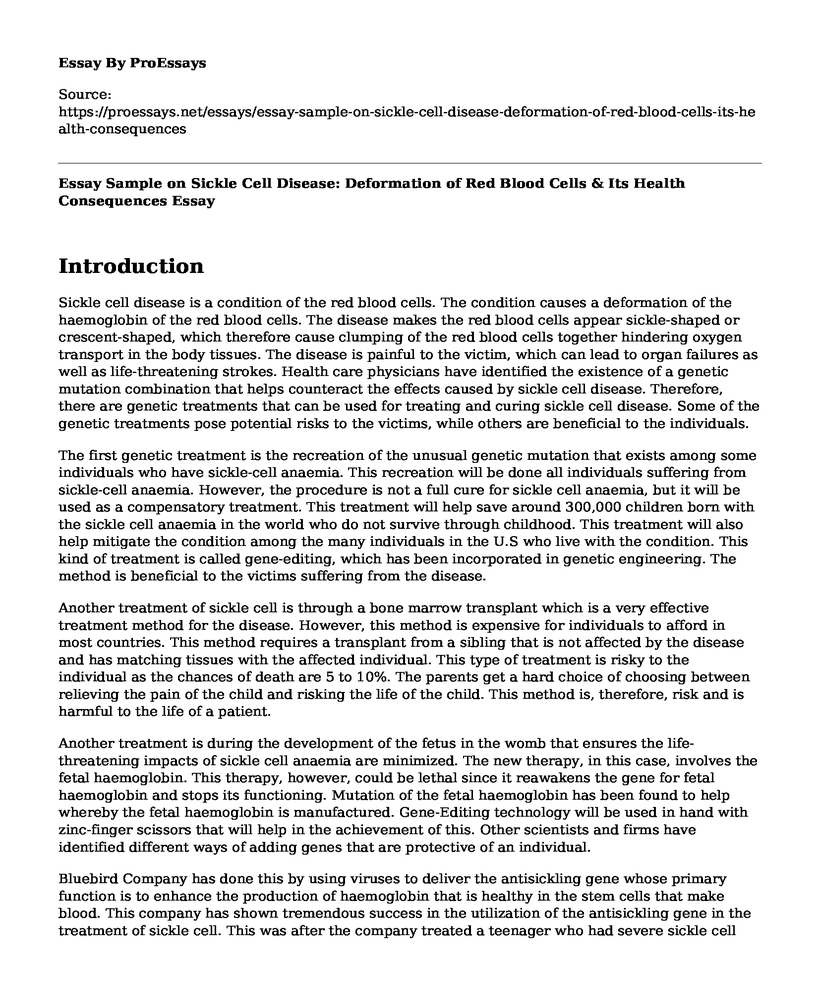Introduction
Sickle cell disease is a condition of the red blood cells. The condition causes a deformation of the haemoglobin of the red blood cells. The disease makes the red blood cells appear sickle-shaped or crescent-shaped, which therefore cause clumping of the red blood cells together hindering oxygen transport in the body tissues. The disease is painful to the victim, which can lead to organ failures as well as life-threatening strokes. Health care physicians have identified the existence of a genetic mutation combination that helps counteract the effects caused by sickle cell disease. Therefore, there are genetic treatments that can be used for treating and curing sickle cell disease. Some of the genetic treatments pose potential risks to the victims, while others are beneficial to the individuals.
The first genetic treatment is the recreation of the unusual genetic mutation that exists among some individuals who have sickle-cell anaemia. This recreation will be done all individuals suffering from sickle-cell anaemia. However, the procedure is not a full cure for sickle cell anaemia, but it will be used as a compensatory treatment. This treatment will help save around 300,000 children born with the sickle cell anaemia in the world who do not survive through childhood. This treatment will also help mitigate the condition among the many individuals in the U.S who live with the condition. This kind of treatment is called gene-editing, which has been incorporated in genetic engineering. The method is beneficial to the victims suffering from the disease.
Another treatment of sickle cell is through a bone marrow transplant which is a very effective treatment method for the disease. However, this method is expensive for individuals to afford in most countries. This method requires a transplant from a sibling that is not affected by the disease and has matching tissues with the affected individual. This type of treatment is risky to the individual as the chances of death are 5 to 10%. The parents get a hard choice of choosing between relieving the pain of the child and risking the life of the child. This method is, therefore, risk and is harmful to the life of a patient.
Another treatment is during the development of the fetus in the womb that ensures the life-threatening impacts of sickle cell anaemia are minimized. The new therapy, in this case, involves the fetal haemoglobin. This therapy, however, could be lethal since it reawakens the gene for fetal haemoglobin and stops its functioning. Mutation of the fetal haemoglobin has been found to help whereby the fetal haemoglobin is manufactured. Gene-Editing technology will be used in hand with zinc-finger scissors that will help in the achievement of this. Other scientists and firms have identified different ways of adding genes that are protective of an individual.
Bluebird Company has done this by using viruses to deliver the antisickling gene whose primary function is to enhance the production of haemoglobin that is healthy in the stem cells that make blood. This company has shown tremendous success in the utilization of the antisickling gene in the treatment of sickle cell. This was after the company treated a teenager who had severe sickle cell disease. The treatment was successful since the child did not require the use of painkillers and the child did not experience any events of sickle cell. This treatment is, however, toxic to the patient as it causes a series of adverse outcomes. The patient could easily acquire cancer, and the patients will have infertility.
Conclusion
In conclusion, sickle cell is a condition that has affected most of the infants that are being born in the world. The condition has been a menace to most of the developed and wealthy countries. However, there have been companies and physicians who have put effort into trying to find the treatment for the disease. Some of the treatment methods involve genetic engineering, and they include, organ transplant, genetic-editing technology and gene therapy. However, these techniques of curing sickle cell have brought many adverse results to both the patients and the parents. Some of the treatment methods could result in death, risks of cancer and infertility by the patient. However, some of the ways are successful and beneficial to the patient, and they eliminate the sickling effect.
Cite this page
Essay Sample on Sickle Cell Disease: Deformation of Red Blood Cells & Its Health Consequences. (2023, Feb 27). Retrieved from https://proessays.net/essays/essay-sample-on-sickle-cell-disease-deformation-of-red-blood-cells-its-health-consequences
If you are the original author of this essay and no longer wish to have it published on the ProEssays website, please click below to request its removal:
- Streptococcal Pharyngitis Paper Example
- Psychosocial Assessment of MedStar National Rehabilitation Network Paper Example
- Essay Sample on Material and Methods of Dentistry
- Problems Experienced by St. George Nursing Home Paper Example
- Essay Sample on Promoting Health & Reducing Risk: Basics of Community/Public Health
- Essay on Non-Professionals: How to Deal With Social Determinants of Health
- Essay Example on Prescription Drug Abuse: A Growing Public Health Crisis







